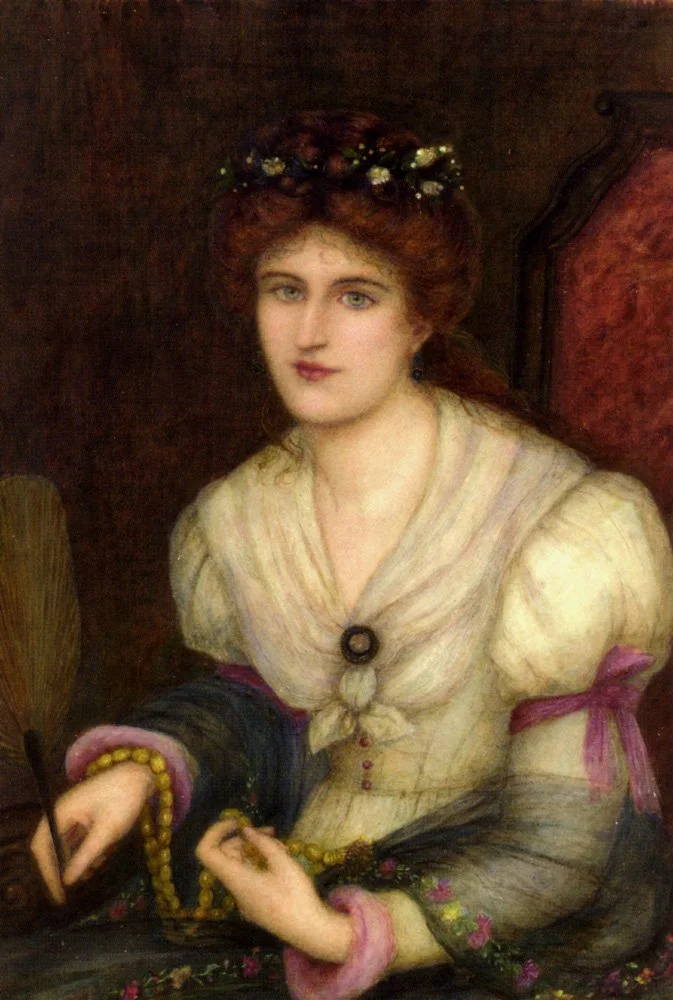English Heritage Blue Plaque for Marie Spartali
Jeanne Rathbone
On 12 May, Battersea Society members Chris and Kate Morgan-Locke hosted the unveiling of the English Heritage blue plaque for Marie Spartali at The Shrubbery. This is the first English Heritage plaque to a woman in Battersea, where there are seventeen English Heritage or London County Council plaques honouring men. Built in the 1770s, the Shrubbery was home to Marie as the eldest daughter of Michael Spartali, merchant and Greek Consul–General from 1864-1885. It had been home to two Lord Mayors of London and became the church hall of St Barnabas.
Marie Spartali Self-portrait
Several of Spartali’s descendants were able to attend the unveiling. Cathy Power, representing English Heritage spoke, as did Jan Marsh, writer and curator expert on Victorian Pre-Raphaelite art who presented Spartali as an artist.
I gave an account of the area, including the Spartali’s neighbours Jeanie Senior and Tom Taylor. Jeanie Senior, the first woman civil servant, lived at Elm House, where Marie and husband William Stillman courted because Marie’s father disproved of their relationship. Michael Spartali hosted Sunday afternoon parties and playwright Tom Taylor of nearby Lavender Sweep House hosted Sunday evening musical soirées that Marie and Jeanie would have attended. On the other side was Gilmore House which later became the Southwark diocese deaconate run by Deaconess Isabella Gilmore who was a sister of William Morris. Jane and William were great friends of Marie’s and she spent time at Kelmscott Manor which she painted.
Our MP Marsha De Cordova was there to thank those who campaigned for the recognition and organised the unveiling and emphasised the need to acknowledge women’s history; Battersea Society member and poet Hilaire read her poem “Battersea Pre-Raphaelite Diptych.”
Below is the press release from English Heritage.
NEWS RELEASE
Marie Spartali Stillman commemorated by English Heritage
- Artist and model is first female Pre-Raphaelite artist to receive an English Heritage blue plaque -
The Pre-Raphaelite model and artist, Marie Spartali Stillman, has been commemorated with a blue plaque at her family home in Battersea, English Heritage announced today (21 April). It was during her time living at The Shrubbery (a Grade II listed building dating from the 1770s on what is now Lavender Gardens) that she first modelled for Pre-Raphaelite artists; Edward Burne-Jones; Dante Gabriel Rossetti; and Ford Madox Brown. The Shrubbery’s grand sweep of reception rooms – furnished in a ‘handsome, showy style’ (William Rossetti Diary, 7 May 1885), with French boulle cabinets, large chandeliers, and carved oak and mahogany furniture – would have been the setting for the Spartali family’s weekly entertainments, and it was while living here that Marie established a reputation as a professional artist in her own right. It was her base from which she painted, prepared her works for exhibition, and sent items out for display at the Royal Academy, and galleries in London, Manchester, Liverpool, and the United States.
Art Historian and Blue Plaques Panel Member, Andrew Graham-Dixon, said: “There are only a handful of female artists commemorated by the blue plaques scheme, and Marie Spartali Stillman is actually the first female Pre-Raphaelite artist to receive one.
“She was an extraordinary figure in 19th-century art, but for a long time, her work was largely unknown. Not because she lacked skill – far from it – but because self-promotion was not considered becoming of a ‘well brought up’ woman. I am delighted that English Heritage is celebrating her with a plaque at her family home in Battersea. Hopefully it will go some way towards bringing her the recognition she deserves.”
While she became renowned for her classic beauty, she was equally admired as painter. Trained by the Pre-Raphaelite painter, Ford Madox Brown, Spartali Stillman was one of only a small number of professional women artists of the late nineteenth century. She worked in a period in which the opportunities for women artists were limited, and when social convention viewed them only as amateurs. She was, however, determined to forge her own career and created a significant body of work – over 150 painting in five decades. Her work is now regularly included in exhibitions about the Pre-Raphaelite movement.
With this new plaque, Marie Spartali Stillman becomes the first female Pre-Raphaelite artist and one of only very few female artists to receive a blue plaque. Other female artists who have been awarded blue plaques include Evelyn de Morgan and Dame Laura Knight, the sculptor Barbara Hepworth, photographer Lee Miller, textile designer Enid Marx and illustrator Kate Greenaway.
The English Heritage London Blue Plaques scheme is generously supported by members of the public.
History of London’s Blue Plaques Scheme: The London-wide blue plaques scheme has been running for 150 years. The idea of erecting 'memorial tablets' was first proposed by William Ewart MP in the House of Commons in 1863. It had an immediate impact on the public imagination, and in 1866 the (Royal) Society of Arts founded an official plaques scheme. The Society erected its first plaque – to poet, Lord Byron – in 1867. The blue plaques scheme was subsequently administered by the London County Council (1901–65) and by the Greater London Council (1965–86), before being taken on by English Heritage in 1986. www.english-heritage.org.uk/discover/blue-plaques/
English Heritage cares for over 400 historic monuments, buildings and sites – from world famous prehistoric sites to grand medieval castles, from Roman forts on the edges of empire to Cold War bunkers. Through these, we bring the story of England to life for over 10 million visitors each year. www.english-heritage.org.uk
Registered charity no. 1140351


